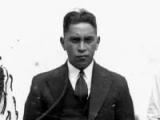What happened that day?
See historic events for any day of the year by entering the date below. Why not try your birthday?
Kiwi of the Week
Today in History

1937 NZ nurses detained on way to Spanish Civil War
Of the small group of New Zealanders who served in the Spanish Civil War, most made their own way to Spain from Britain and Australia. The only organised New Zealand contingent comprised three nurses: René Shadbolt, Isobel Dodds, and Millicent Sharples.
The nurses were recruited by the New Zealand Spanish Medical Aid Committee (SMAC), which was formed in February 1937 once it became obvious that there would be no official New Zealand involvement in the war. SMAC initially planned to send a doctor, two nurses, an orderly and an ambulance to Spain but abandoned this broader plan in order to provide aid as soon as possible. René Shadbolt, aged 33, who was head sister of Auckland Hospital's casualty ward, was appointed to lead the group. Isobel Dodds, aged 22, a staff nurse from Wellington Hospital and Millicent Sharples, aged 46, who worked at a private hospital in Levin, made up the rest of the contingent.
On the day of their departure from Auckland, 18 May 1937, the nurses were summoned to the Central Police Station. They were interrogated for three hours about their reasons for going to Spain. A ‘slightly different tactic' was taken with each. Shadbolt was accused of being a member of a Communist Party, Dodds of having an illegitimate child, while the police concluded that Sharples, the oldest of the group, was simply naïve. The nurses were eventually released in time to board their ship, the Awatea, but SMAC was outraged. They wrote to the government demanding an explanation and an inquiry into the matter. Neither was forthcoming, although Police Minister Peter Fraser - who was a family friend of Dodds - did eventually admit that the government had overacted in response to their fear of ‘three dedicated revolutionaries flying New Zealand's flag in Spain'.
The nurses arrived in Spain, via Australia and England, on 15 July 1937. They were first based at a large makeshift International Brigade hospital in Huete, central Spain. Shadbolt and Dodds remained there until mid 1938 when the fighting grew too close and the hospital was evacuated to Barcelona.
By this time Sharples had left Spain. She had been posted to the Aragon front to serve as an ambulance driver in October 1937. Then, following several other transfers, SMAC recalled her to New Zealand. It is unclear what prompted her recall but SMAC was certainly displeased with her performance once she returned to New Zealand. In July 1938 they severed all official connections with her.
Shadbolt and Dodds meanwhile continued to be a key promotional tool for SMAC in New Zealand. Their photographs were used on posters, and their letters home were printed in newspapers and in SMAC's regular newsletter. Following a month's leave in England in June 1938 the pair returned to Spain, this time serving in a large hospital at Mataro, on the coast north of Barcelona. As the war drew to an close in September they were once again evacuated to Barcelona. They withdrew from the city shortly after the ‘stirring and emotional' farewell parade of the International Brigades on 15 November.
Dodds and Shadbolt arrived back in New Zealand in January 1939. While searching for nursing positions they continued their work for SMAC. In February they embarked upon a six-week speaking tour to raise awareness of and money for the hundreds of thousands of Republican refugees in France.
Image: Nurse Dodds, Sister Shadbolt and Nurse Sharples
Internal links
External links

1966 Death of Maori King Koroki
Koroki Te Rata Mahuta Tawhiao Potatau Te Wherowhero was the fifth Maori monarch, heading the Kingitanga movement that began in 1858 in response to European colonisation.
Born at Waahi, Huntly, in 1909, he was the eldest son of Te Rata, the fourth Maori king. When his father died in 1933 he did not want to become king. There was some support for appointing Te Puea Herangi as the first Maori queen. But while Koroki questioned his own ability to be king at his father's funeral, the visiting chiefs agreed that he should succeed his father.
His reign was a difficult one. He believed that the poverty of his people made supporting a king difficult. Some Maori leaders, including Apirana Ngata, questioned his position and title, opposing any leadership that challenged the sovereignty of Parliament. The government adopted a similar position, and in 1939 refused to exempt him from registering under the social security regulations. Many supporters of the Kingitanga viewed this as a sign of disrespect, and the movement boycotted the Treaty centennial celebrations in 1940.
From the late 1950s Koroki's health deteriorated and he avoided public life. As this point Te Puea took his eldest daughter, Piki Mahuta, across the country to represent the Kingitanga at various functions and ceremonies. When Koroki died at Ngaruawahia in 1966, Piki was chosen as the first Maori queen. She was crowned as Te Arikinui Te Atairangikaahu a few hours before her father's burial on 23 May 1966.














